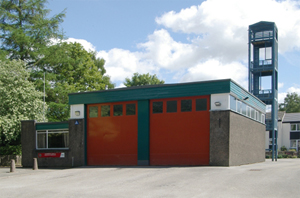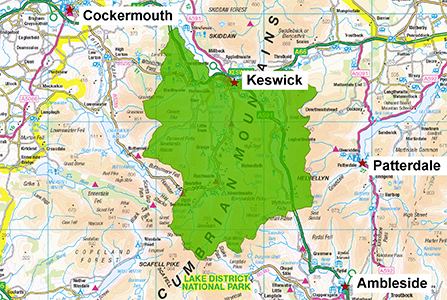Keswick Fire Station

Keswick Fire Station
Penrith Road
Keswick
CA12 4PA
Tel: 0300 303 8623 Monday to Friday 9 a.m. to 5 p.m.
Training Evening: Wednesday 1815 hrs to 2015 hrs.
Email: enquiries.fire@cumbria.gov.uk
Keswick fire station is staffed by On-call Firefighters and houses one fire engine and a Wildfire Land Rover.
The main risks are associated with residential properties, hotels, guest houses and other types of holiday accommodation. Other risks include the large volumes of traffic on the predominantly 'B' type roads and the busy Penrith to Workington A66, which increases the potential for road traffic collisions. Open farmland and fells brings the danger of agricultural and wildfires, in addition to other farm incidents, such as livestock rescues. Firefighters receive specialist training to deal with Wildfire incidents. With many rivers and three major lakes within the station area, the potential for water rescue incidents is high, so firefighters are trained as water first responders.
Cumbria Fire and Rescue Service carry out Safe and Well Visits; please use the link below for more information.
Safe and Well Visits and Safety in your home

Next nearest supporting Fire Engine
Penrith - 17 miles
Cockermouth - 14 miles
Ambleside - 16 miles
| Station Area | 6,700 population |
| Crewing Type | On-Call |
| Fire Engines | 1 fire engine and 1 Wildfire Land Rover |
The station was built in 1969 and incorporates a drill yard and tower, in addition to the two appliance bays. Keswick firefighters have specific training and equipment to deal with wildfire and flood related incidents.
The area contains:
5 Heritage Sites; Castle Rigg Stone Castle, Derwent Island House, Mire House, Force Crag Mine, Threlkeld Settlement
There is 1 Grade I listed building and 7 Grade II listed buildings
4 Special Areas of Conservation and 32 Sites of Specific Scientific Interest
Derwent Isle is a Site Specific Risk
Flood Risk: The Town has been affected by severe floods over recent years and the Environment Agency and United Utilities have invested heavily to provide engineered solutions to the flooding problems. However flooding from surface water remains a risk to some areas of the town. Keswick is situated on the River Greta, immediately upstream of its confluence with the River Derwent. The Flood Warning area covers approximately 2.48 Km2 and includes low lying property, parkland and campsite between Low Briery on the River Greta to where the River Derwent enters Derwentwater Lake. There are approximately 800 properties at risk with major flooding occurring in 1954, 1985, 2004, 2005 and 2009, and minor events every few years in between.
The town of Keswick lies in the heart of the Lake District and is very popular with holiday makers and people coming for long weekends. The influx of tourists often increases the town's population threefold at the height of the season, filling many of the hotels and guest houses, significantly increasing the sleeping risk.
The main risks are associated with residential properties, hotels, guest houses and other types of holiday accommodation. However, other risks include large volumes of traffic on the predominantly 'B' type roads and the busy Penrith to Workington A66, which increases the potential for road traffic collisions. Open farmland brings the danger of barn and heath fires, in addition to other farm incidents, such as livestock rescues.
With three major lakes within the station area, the potential for water rescue incidents is high, as is the possibility of flooding which has resulted in some significant rescue operations in recent years.
The table shows the number of incidents that have occurred within a nominal area assigned to the station (as shown on the map in the station profile). This is different to the number of incidents attended by fire engines which are based at the station, as they may attend incidents outside their station area.
| Fire | 2017/18 | 2018/19 | 2019/20 | |
| All emergencies attended | 60 | 70 | 75 | |
| All Fires | 7 | 21 | 18 | |
| Accidental primary dwelling fires | 0 | 1 | 3 | |
| Secondary fires | 1 | 6 | 10 | |
| Chimney fires | 2 | 1 | 3 | |
| Deliberate primary fires | 1 | 1 | 0 | |
| Deliberate secondary fires | 1 | 2 | 2 | |
| False Alarms | ||||
| All false alarms | 40 | 36 | 43 | |
| Special Service Calls | ||||
| Non Road Traffic Collisions Special Service Calls | 9 | 5 | 8 | |
| Road Traffic Collisions Special Service Calls | 4 | 8 | 6 |
Response times
On-call fire engine
| C07P1 | 2017/18 | 2018/19 | 2019/20 |
| Average crew turnout time (time it takes the crew to respond to the station) | 4 mins 53 secs | 5 mins 6 secs | 4 mins 14 secs |
| Average response time (time it takes the crew to arrive at the incident from the station) | 7 mins 45 secs | 15 mins 12 secs | 11 mins 43 secs |
| Number of incidents attended by fire engine C07P1 | 70 | 89 | 87 |
Availability
On-call fire engine
| C07P1 | 2017/18 | 2018/19 | 2019/20 |
| Total Availability | 99% | 98% | 99% |
| Mon - Fri (08:00 - 18:00) | 100% | 96% | 99% |
| Mon - Thurs (18:00 - 08:00) | 100% | 99% | 100% |
| Fri - Mon (18:00 - 08:00) | 99% | 98% | 98% |
Further information for this fire station is available on a number of themes at the Cumbria Intelligence Observatory, including:
Population
Crime and Community
Health and Social Care
Housing
Economy and Employment
Environment
Children and Young People
Please visit www.cumbriaobservatory.org.uk and choose a fire station area for your particular theme of interest.